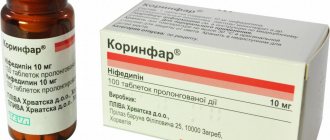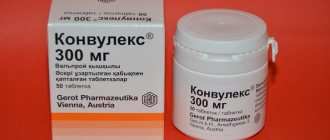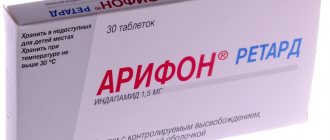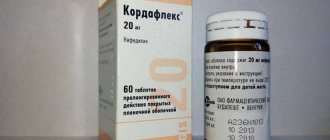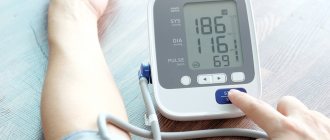Release form and composition
Isoptin is available in the following dosage forms:
- Film-coated tablets: white, biconvex, round; 40 mg each - with the inscription “40” on one side and an engraving in the form of a triangle on the other; 80 mg each - with the inscription “ISOPTIN 80” on one side and a scoring line and the inscription “KNOLL” on the other (tablets of 40 and 80 mg: 10 pieces in blisters, 2 or 10 blisters in a cardboard pack; 20 each pieces in blisters, 1 or 5 blisters in a cardboard box; tablets of 80 mg: 25 pieces in blisters, 4 blisters in a cardboard box);
- Solution for intravenous administration: colorless, transparent (2 ml in colorless glass ampoules, 5, 10 or 50 ampoules in pallets or blisters, 1 blister or pallet in a cardboard box).
1 tablet contains:
- Active substance: verapamil – 40 or 80 mg (in the form of hydrochloride);
- Auxiliary components (40/80 mg, respectively): calcium hydrogen phosphate dihydrate – 70/140 mg; microcrystalline cellulose – 23/46 mg; colloidal silicon dioxide – 0.7/1.4 mg; croscarmellose sodium – 1.8/3.6 mg; Magnesium stearate – 1.5/3 mg.
Film shell composition (40/80 mg, respectively): sodium lauryl sulfate – 0.1/0.1 mg; hypromellose 3 mPa – 1.7/2 mg; talc – 4/4.5 mg; macrogol 6000 – 2/2.3 mg; titanium dioxide – 1/1.1 mg.
1 ampoule contains:
- Active substance: verapamil – 5 mg (in the form of hydrochloride);
- Auxiliary components: hydrochloric acid 36% - to adjust the pH; sodium chloride – 17 mg; water for injection – up to 2 ml.
Indications for use
Isoptin in tablet form is prescribed for the treatment of the following diseases:
- Arterial hypertension;
- Paroxysmal supraventricular tachycardia;
- Coronary heart disease, including unstable angina, chronic stable angina (classical exertional angina), Prinzmetal's angina (angina that is caused by vasospasm);
- Atrial fibrillation/flutter, which is accompanied by tachyarrhythmia (except Lown-Ganong-Levine (LGL) and Wolff-Parkinson-White (WPW) syndrome).
The drug in the form of a solution for intravenous administration is used in the treatment of supraventricular tachyarrhythmias. Isoptin is prescribed for the following indications:
- Restoration of sinus rhythm in paroxysmal supraventricular tachycardia, including conditions that are associated with the presence of additional pathways (Lown-Ganong-Levine and Wolff-Parkinson-White syndromes);
- Monitoring the frequency of ventricular contractions during atrial fibrillation and flutter (tachyarrhythmic variant), except in cases where atrial fibrillation or flutter is associated with the presence of additional pathways (Lown-Ganong-Levine and Wolff-Parkinson-White syndromes).
Analogues of the drug according to ATC codes:
VERAPAMIL VERAPAMIL SOPHARMA VEROGALID ER 240 ISOPTINE ISOPTINE SR 240
Before using ISOPTINE, you should consult your doctor. These instructions for use are for informational purposes only. For more complete information, please refer to the manufacturer's instructions.
Contraindications
- AV block II-III degree (except for patients with an artificial pacemaker);
- Sick sinus syndrome (bradycardia-tachycardia syndrome, except for patients with an artificial pacemaker);
- Atrial fibrillation/flutter in the presence of additional conduction pathways (Lown-Ganong-Levine and Wolff-Parkinson-White syndrome);
- Age up to 18 years (the effectiveness and safety of the drug for this age group of patients have not been established);
- Hypersensitivity to the components of the drug.
Additional contraindications to taking Isoptin in tablet form are:
- Chronic heart failure;
- Acute myocardial infarction, complicated by severe arterial hypotension, bradycardia and left ventricular failure;
- Cardiogenic shock;
- Simultaneous use with colchicine.
Intravenous administration of Isoptin is contraindicated in the presence of the following diseases/conditions:
- Arterial hypotension or cardiogenic shock (other than caused by arrhythmia);
- Morgagni-Adams-Stokes syndrome;
- Sinoauricular block;
- Ventricular tachycardia with wide QRS complexes (more than 0.12 seconds);
- Chronic heart failure stage IIB-III (except for those caused by supraventricular tachycardia, which is subject to treatment with verapamil);
- Pre-use of disopyramide (within 48 hours);
- Simultaneous intravenous administration of beta-blockers;
- Pregnancy and lactation period.
Isoptin in all medicinal forms should be used with caution in case of bradycardia and 1st degree AV block.
The drug is prescribed orally with caution in cases of severe functional disorders of the kidneys and liver, arterial hypotension, diseases related to neuromuscular transmission, including Lambert-Eaton syndrome, myasthenia gravis and Duchenne muscular dystrophy.
Intravenous administration is recommended with caution in elderly patients, as well as in the following diseases: heart failure, severe aortic stenosis, myocardial infarction with left ventricular failure, mild or moderate arterial hypotension, renal and/or liver failure.
Overdose
Symptoms of poisoning resulting from an overdose of Isoptin CP 240 depend on the amount of the drug taken, the time of detoxification measures and the contractility of the myocardium, which depends on age. Fatal cases resulting from overdose have been reported.
Symptoms:
drop in blood pressure (in some cases to levels that cannot be measured), shock, loss of consciousness, 1st or 2nd degree AV block, often as Wenckebach periods with or without escape rhythm, complete AV block with complete AV dissociation, escape rhythm, cardiac arrest; sinus bradycardia, sinus node arrest.
In case of an overdose of Isoptin CP 240, it must be borne in mind that the active substance is released and absorbed from the intestine within 48 hours after taking the drug orally. Depending on the time of taking the drug, individual conglomerates of swollen tablet residues, acting as active depots, will be located throughout the gastrointestinal tract.
Treatment:
measures aimed at removing the drug are indicated (for example, induce vomiting, rinse the stomach and intestines in combination with endoscopic examination, prescribe laxatives and emetics). If there is no motility of the stomach and intestines (signs of peristalsis during auscultation), then it is advisable to perform gastric lavage even 12 hours after taking the drug orally. Common emergency resuscitation measures include chest compressions, artificial respiration, and electrical stimulation of the heart.
Effects associated with depression of cardiac function, arterial hypotension and bradycardia should be excluded.
Calcium is a specific antidote: 10-30 ml of a 10% calcium gluconate solution is administered as an intravenous infusion (2.25-4.5 mmol), if necessary, re-introduced or as a slow drip infusion (5 mmol/h).
In the case of AV blockade of the second or third degree, sinus bradycardia, cardiac arrest, administration of atropine, isoprenaline, orciprenaline, and cardiac stimulation are indicated.
In case of arterial hypotension, dopamine, dobutamine, and norepinephrine (norepinephrine) are administered.
In case of persistent signs of myocardial failure, dopamine, dobutamine are administered, and, if necessary, additional calcium is administered.
Directions for use and dosage
Isoptin in tablet form is taken orally, swallowed whole (cannot be chewed or dissolved) and washed down with water. It is preferable to take the drug during or immediately after a meal.
The regimen for using Isoptin is determined individually, taking into account the severity of the disease and the clinical picture.
For all recommended indications, the average daily dose is 240-480 mg. For long-term therapy, the daily dose of 480 mg should not be exceeded. The maximum daily dose of Isoptin should be taken only in a hospital setting.
The initial single dose is 40-80 mg, the frequency of administration is 3-4 times a day.
For patients with functional liver disorders, it is recommended to start therapy with a single dose of 40 mg. Frequency of administration – 2-3 times a day. In the future, the doctor selects the dose individually.
Isoptin in the form of an injection solution can only be administered intravenously.
Administration should be carried out slowly with continuous monitoring of ECG and blood pressure for at least 2 minutes (in elderly patients - 3 minutes, which reduces the risk of unwanted effects).
The initial dose is 5-10 mg (0.075-0.15 mg/kg body weight). If the response to the first injection is inadequate, a second dose (10 mg) can be administered after 30 minutes.
Dosage regimen
The average daily dose of the drug is 240-360 mg. For long-term treatment, the daily dose should not exceed 480 mg; a temporary dose increase above this level is possible.
For ischemic heart disease (chronic stable angina; angina caused by vasospasm /Prinzmetal angina, variant/)
Isoptin CP 240 is prescribed in a daily dose of 240-480 mg (1/2-1 tablet 2 days with an interval of 12 hours).
For hypertension (mild or moderate)
Isoptin CP 240 is prescribed 240 mg (1 tablet) 1 time/day. in the morning. If a slow decrease in blood pressure is preferred, then treatment should begin with a dose of 120 mg (1/2 tablet of Isoptin CP 240) 1 time / day. in the morning. If necessary, additionally prescribe 1/2-1 tablet in the evening with an interval between doses of about 12 hours. If necessary, the dose should be increased every 2 weeks of treatment.
For paroxysmal supraventricular tachycardia, atrial fibrillation/flutter, accompanied by tachyarrhythmia
Isoptin CP 240 is prescribed 120-240 mg (1/2-1 tablet) 2 days. with an interval of 12 hours.
In case of liver dysfunction
the effect of the drug is enhanced and becomes longer lasting as a result of the slow metabolism of verapamil, which depends on the severity of liver dysfunction. In such cases, the dose should be set with extreme caution; treatment should begin with taking the drug in lower doses (i.e., patients with liver cirrhosis are prescribed the drug Isoptin 40 mg 2-3 days).
The tablets should be taken during meals or immediately after meals, swallowed whole and washed down with water.
The duration of use is not limited.
Side effects
During therapy, it is possible to develop disorders of some body systems:
- Digestive system: pain and discomfort in the abdomen, vomiting, nausea, constipation, intestinal obstruction; in some cases - a transient increase in the activity of liver transaminases and alkaline phosphatase in the blood plasma; rarely – gum hyperplasia (pain, bleeding, swelling), increased appetite, diarrhea;
- Cardiovascular system: severe bradycardia, facial flushing, atrioventricular block, marked decrease in blood pressure, the appearance of symptoms of heart failure when using high doses of the drug, especially in predisposed patients; palpitations, tachycardia, sinus node arrest; rarely - arrhythmia (including ventricular flutter and fibrillation), angina pectoris up to the development of myocardial infarction (especially in patients with severe obstructive lesions of the coronary arteries), bradycardia;
- Nervous system: general weakness, anxiety, depression, drowsiness, extrapyramidal disorders (stiffness of the legs or arms, ataxia, shuffling gait, mask-like face, difficulty swallowing, tremors of the hands and fingers), headache, dizziness, convulsions during drug administration, tremor , paresthesia; in rare cases - lethargy, increased nervous excitability, fatigue;
- Allergic reactions: exudative erythema multiforme, facial skin flushing, skin rash, itching, Stevens-Johnson syndrome, bronchospasm;
- Other: weight gain; very rarely - arthritis, agranulocytosis, transient blindness at the peak concentration of the drug in the blood, asymptomatic thrombocytopenia, pulmonary edema, development of peripheral edema, fatigue, hyperprolactinemia, gynecomastia, impotence, galactorrhea, muscle weakness, increased sweating, joint pain, myalgia.
Most of the listed side effects are characteristic of all dosage forms of Isoptin.
Isoptin
Release form, composition and packaging
Solution for intravenous administration
- 1 amp. verapamil hydrochloride 5 mg
Clinical and pharmacological group: Calcium channel blocker
pharmachologic effect
Verapamil blocks the transmembrane entry of calcium ions (and possibly sodium ions) into the cells of the myocardial conduction system and the smooth muscle cells of the myocardium and blood vessels. The antiarrhythmic effect of verapamil is probably due to its effect on the “slow” channels in the cells of the cardiac conduction system.
The electrical activity of the sinoatrial and atrioventricular nodes largely depends on the entry of calcium into the cells through “slow” channels. By inhibiting this calcium entry, verapamil slows atrioventricular conduction and increases the effective refractory period in the atrioventricular node in proportion to heart rate. This effect leads to a decrease in the ventricular rate in patients with atrial fibrillation and/or atrial flutter. By stopping the reentry of excitation in the atrioventricular node, veralamil can restore correct sinus rhythm in patients with paroxysmal supraventricular tachycardia, including Wolff-Parkinson-White (WPW) syndrome. Verapamil does not affect conduction along additional pathways.
Verapamil does not affect the unchanged atrial action potential and intraventricular conduction time, but reduces the amplitude, rate of depolarization and conduction in altered atrial fibers.
Verapamil does not cause spasm of peripheral arteries and does not change the total calcium content in the blood plasma.
Verapamil reduces afterload and myocardial contractility. In most patients, including patients with organic heart disease, the negative inotropic effect of verapamil is leveled out by a decrease in afterload, the cardiac index usually does not change, but in patients with moderate and severe heart failure (pulmonary artery wedge pressure more than 20 mm Hg, ejection fraction less than 30%), progression of circulatory failure may occur. The maximum therapeutic effect is observed 3-5 minutes after a bolus intravenous administration of verapamil.
Usual doses of verapamil 5-10 mg when administered intravenously cause a transient, usually asymptomatic decrease in normal blood pressure (BP), systemic vascular resistance and contractility, and left ventricular filling pressure increases slightly.
Pharmacokinetics
Verapamil hydrochloride is rapidly metabolized when administered intravenously. The blood concentration curve is bi-exponential with a fast early distribution phase (half-life of about 4 minutes) followed by a slower terminal elimination phase (half-life of 2-5 hours).
The binding to plasma proteins is about 90%. The drug undergoes intensive metabolism with the formation of a large number of metabolites (12 were identified when taking the drug orally, most of which are found only in trace concentrations). Among the metabolites, only norverapamil has a pharmacological effect (about 20% compared to the parent compound).
Verapamil hydrochloride and its metabolites are excreted 70% by the kidneys (3-5% unchanged), 25% by the bile. Not excreted during hemodialysis. Impaired renal function does not affect the pharmacokinetics of verapamil hydrochloride, as shown in comparative studies in patients with end-stage renal failure and healthy patients. The half-life is increased in patients with impaired liver function due to decreased first-pass metabolism and increased volume of distribution.
Verapamil penetrates the blood-brain and placental barriers and is excreted in breast milk.
Indications
For the treatment of supraventricular tachyarrhythmias:
- Restoration of sinus rhythm in paroxysmal supraventricular tachycardia, including conditions associated with the presence of additional pathways (Wolf-Parkinson-White (WPW) and Lown-Ganong-Levine (LGL) syndromes).
- Controlling the frequency of ventricular contractions during atrial flutter and atrial fibrillation (tachyarrhythmic variant), except in cases where atrial flutter or fibrillation is associated with the presence of additional pathways (WPW and LGL syndromes).
Dosage regimen
Only intravenously!
Intravenous administration should be administered slowly over at least 2 minutes with continuous monitoring of ECG and blood pressure. In elderly patients, administration is carried out over at least 3 minutes to reduce the risk of unwanted effects.
The initial dose is 5-10 mg (0.075-0.15 mg/kg body weight).
A repeat dose of 10 mg (0.15 mg/kg body weight) is administered 30 minutes after the first injection if the response to the first injection is inadequate
Side effect
Side effects, depending on the effect on organs and organ systems, are presented in the following order: frequent (≥1/100, <1/10), uncommon (≥1/1000, <1/10):
From the nervous system: dizziness, headache.
From the cardiovascular system: bradycardia, tachycardia, arterial hypotension.
From the digestive system: nausea, feeling of discomfort in the abdomen. Several cases of seizures have been reported during drug administration. Hypersensitivity reactions, bronchospasm and urticaria have occurred very rarely.
The following adverse reactions have been observed extremely rarely.
From the nervous system: drowsiness.
Skin and subcutaneous tissue disorders: Stevens-Johnson syndrome, exudative erythema multiforme, sweating. A single case of paralysis (tetraparesis) associated with the combined use of verapamil and colchicine has been reported.
Contraindications
- hypersensitivity to the drug and its components,
- arterial hypotension or cardiogenic shock (except caused by arrhythmia),
- atrioventricular block II and III degrees (excluding patients with an artificial pacemaker);
- Morgagni-Adams-Stokes syndrome,
- sick sinus syndrome (excluding patients with an artificial pacemaker);
- sinoauricular blockade,
- Wolff-Parkinson-White (WPW) and Lown-Ganong-Levine (LGL) syndrome in combination with atrial flutter or fibrillation (except for patients with a pacemaker)
- ventricular tachycardia with wide QRS complexes (>0.12 sec)
- chronic heart failure stage II B - III (except for those caused by supraventricular tachycardia, subject to treatment with verapamil)
- simultaneous use of beta-blockers (intravenously),
- preliminary (within 48 hours) use of disopyramide
- pregnancy, lactation period,
- age under 18 years (efficacy and safety have not been established).
The drug should be prescribed with caution in case of first degree atrioventricular block, bradycardia, severe aortic stenosis, chronic heart failure stage I-IIA, mild or moderate arterial hypotension, myocardial infarction with left ventricular failure, liver and/or renal failure, slowing of neuromuscular transmission and in elderly patients.
Pregnancy and lactation
Data not provided.
special instructions
Impact on the ability to drive a car and use equipment
Depending on the individual characteristics of the patient, Isoptin may change the reaction rate, impairing the ability to drive a car, operate machinery, or in hazardous conditions.
Overdose
Symptoms: sinus bradycardia, turning into atrioventricular block, sometimes asystole, marked decrease in blood pressure, heart failure, shock, sinoatrial block, hyperglycemia, metabolic acidosis. There have been reports of deaths due to overdose.
Treatment: in case of rhythm and conduction disturbances - intravenous administration of isoprenaline, norepinephrine, 10-20 ml of 10% calcium gluconate solution, artificial pacemaker; intravenous infusion of plasma replacement solutions. Hemodialysis is not effective.
To increase blood pressure in patients with hypertrophic cardiomyopathy, alpha-adrenergic agonists (phenylephrine) are prescribed; Isoprenaline and norepinephrine should not be used.
Drug interactions
Cimetidine
Does not affect the kinetics of verapamil hydrochloride solution.
Drugs that bind to plasma proteins
Verapamil, as a drug that is highly bound to plasma proteins, should be used with caution when taken simultaneously with other drugs that have a similar ability.
special instructions
It is impossible to abruptly stop taking Isoptin. It is recommended to reduce the dose gradually until therapy is completely discontinued.
Intravenous administration of Isoptin may cause a transient decrease in blood pressure, which is usually not clinically manifested, but may be accompanied by the development of dizziness.
Circulatory failure (except for severe or caused by arrhythmia) before starting therapy with Isoptin must be compensated for with diuretics and cardiac glycosides. In patients with severe and moderate heart failure, acute progression of circulatory failure may occur during therapy.
The solution does not contain antimicrobial or bacteriostatic agents and is intended for simultaneous intravenous administration.
Isoptin is stable for at least 24 hours (if stored at temperatures up to 25°C, protected from light) in most large volume parenteral solutions. After taking a portion of the contents of any volume, the unused solution should be immediately destroyed.
To avoid instability, diluting Isoptin with sodium lactate solutions in polyvinyl chloride plastic bags is not recommended. It is necessary to avoid mixing Isoptin solutions with amphotericin B, albumin, hydralazine hydrochloride or trimethoprim and sulfamethoxazole.
Verapamil hydrochloride precipitates in any solution with a pH greater than 6.
Isoptin, depending on individual characteristics, can change the reaction rate, impairing the ability to drive a car and perform work that requires increased attention.
Pharmacological action of Isoptin
In accordance with the instructions for Isoptin, the active ingredient in the drug is verapamil hydrochloride.
Isoptin has antihypertensive and antianginal effects on the body. It is a blocker of the transmembrane entry of calcium ions into myocardial cells and vascular smooth muscle cells.
The antianginal effect of the drug is due to the direct influence of the active substance included in the drug on peripheral hemodynamics and myocardium. Both Isoptin 240 and Isoptin 40 help reduce the tone of peripheral arteries and total peripheral vascular resistance.
The antihypertensive effect of the drug is associated with a decrease in peripheral vascular resistance without an increase in heart rate. In accordance with the instructions for Isoptin, a decrease in blood pressure occurs on the first day of treatment. The therapeutic effect is maintained during long-term therapy.
Isoptin has vasodilating, negative inotropic and chronotropic properties.
The drug has an antiarrhythmic effect, which is due to its effect on the small channels of the cells of the conduction system of the heart, which is especially effective for supraventricular arrhythmia.
Isoptin has a high ability to be absorbed from the small intestine and penetrate the placental barrier. With repeated doses, the bioavailability of the drug increases by 2 times compared to a single dose. The binding of Isoptin to blood plasma proteins is about 90%. The drug is metabolized almost completely. The period of complete elimination of Isoptin from the body with a single dose ranges from 6 to 14 hours, with multiple doses it increases by 2 times. The drug is excreted through the kidneys.
Drug interactions
With the simultaneous use of Isoptin with inhibitors of the CYP3A4 isoenzyme, an increase in the concentration of verapamil in the blood plasma is observed, with inducers of the CYP3A4 isoenzyme - a decrease in its concentration (the interaction should be taken into account when using such drugs simultaneously).
When Isoptin is used simultaneously with certain drugs, undesirable effects may occur (Css is the average equilibrium concentration of the substance in the blood plasma, Cmax is the maximum concentration of the substance in the blood plasma, AUC is the area under the pharmacokinetic concentration-time curve, T1/2 is the half-life ):
- Prazosin: increase in its Cmax, T1/2 of prazosin does not change;
- Terazosin: increase in its AUC and Cmax;
- Quinidine: decreased clearance;
- Theophylline: decrease in its systemic clearance;
- Carbamazepine: increase in its AUC in patients with resistant partial epilepsy;
- Imipramine: increase in its AUC; Isoptin has no effect on the concentration of the active metabolite of imipramine - desipramine;
- Glibenclamide: increase in its Cmax and AUC;
- Clarithromycin, erythromycin, telithromycin: possible increased concentrations of verapamil;
- Rifampicin: decreased AUC, Cmax and bioavailability of verapamil when taken orally;
- Doxorubicin: an increase in its AUC and Cmax in patients with small cell lung cancer;
- Phenobarbital: increased clearance of verapamil;
- Buspirone, midazolam: increase in their AUC and Cmax;
- Metoprolol, propranolol: increase in their AUC and Cmax in patients with angina pectoris;
- Digitoxin: reduction of its general and extrarenal clearance;
- Digoxin: increase in its Cmax, AUC and Css;
- Cimetidine: increased AUC of the R-enantiomer and S-enantiomer of verapamil with a corresponding decrease in the clearance of R- and S-verapamil;
- Cyclosporine: increase in its AUC, Css, Cmax;
- Sirolimus, tacrolimus, lovastatin: their concentrations may increase;
- Atorvastatin: its concentration and AUC may increase;
- Simvastatin, almotriptan: increase in their AUC and Cmax;
- Sulfinpyrazone: increased clearance of verapamil and decreased bioavailability;
- St. John's wort: decrease in AUC of the R-enantiomer and S-enantiomer of verapamil with a corresponding decrease in Cmax;
- Grapefruit juice: increase in AUC and Cmax of the R-enantiomer and S-enantiomer of verapamil (renal clearance and T1/2 do not change);
- Terazosin, prazosin: additive hypotensive effect;
- Diuretics, antihypertensives, vasodilators: increased hypotensive effect;
- Ritonavir and other antiviral drugs for the treatment of HIV infection: inhibition of the metabolism of verapamil is possible, which can lead to an increase in its concentration in the blood plasma (with simultaneous use of the dose of Isoptin should be reduced);
- Quinidine: possible increased hypotensive effect; in patients with hypertrophic obstructive cardiomyopathy, pulmonary edema may develop;
- Carbamazepine: increasing its concentration in blood plasma; it is possible to develop adverse reactions characteristic of carbamazepine (headache, diplopia, dizziness or ataxia);
- Lithium: increased neurotoxicity;
- Rifampicin, sulfinpyrazone: the hypotensive effect of verapamil may be reduced;
- Muscle relaxants: their effect may be enhanced;
- Acetylsalicylic acid: increased bleeding;
- Colchicine: a significant increase in its concentration in the blood is possible;
- Ethanol (alcohol): an increase in its concentration in the blood plasma;
- Beta-blockers, antiarrhythmic drugs: mutual enhancement of cardiovascular effects (more significant decrease in heart rate, more pronounced AV blockade, increased arterial hypotension and development of symptoms of heart failure).
For patients taking Isoptin, treatment with lipid-lowering drugs - HMG-CoA reductase inhibitors (lovastatin, simvastatin, atorvastatin) should be started with the lowest possible doses, which are gradually increased with continued therapy. If it is necessary to use Isoptin in patients already receiving HMG-CoA reductase inhibitors, one should consider reducing the dose of statins and re-titrating the dose, taking into account the concentration of cholesterol in the blood serum. Fluvastatin, rosuvastatin and pravastatin are not metabolized by the CYP3A4 isoenzyme, so their interaction with verapamil is least likely.
Pharmacokinetics
Suction
When taken orally, it is quickly and almost completely absorbed in the small intestine. The degree of absorption is 90-92%. The average systemic bioavailability in healthy volunteers after a single dose of the drug is 22%. Studies in patients with atrial fibrillation or angina showed mean bioavailability levels of 35% and 24% after a single oral and IV dose, respectively. With repeated administration of the drug, bioavailability increases almost 2 times compared with a single dose (this effect is probably due to partial saturation of liver enzyme systems and/or a transient increase in blood circulation in the liver after a single dose of verapamil).
Distribution
In case of coronary artery disease and arterial hypertension, no correlation was found between the therapeutic effect and the concentration of the drug in the blood plasma; there is only a definite relationship between plasma drug levels and the effect on the PR interval.
After administration of a prolonged-release dosage form, the plasma concentration curve of verapamil stretches and becomes flatter than with the administration of normal-release dosage forms.
Plasma protein binding is 90%.
Penetrates the placental barrier; concentrations found in umbilical vein plasma were 20–92% of maternal plasma concentrations.
It is excreted in breast milk, but when used in therapeutic doses, its concentrations are so low that a clinical effect in newborns is unlikely.
Metabolism
Verapamil undergoes a first-pass effect through the liver. Almost completely metabolized. The main metabolite is norverapamil, which has pharmacological activity; other metabolites are largely inactive.
Removal
T1/2 ranges from 3 to 7 hours after a single oral dose. With repeated doses, T1/2 of verapamil can increase almost 2 times compared to a single dose.
Verapamil and its metabolites are excreted primarily through the kidneys (3-4% unchanged). Within 24 hours, 50% of the administered dose is excreted, within 48 hours - 55-60%, within 5 days - 70%. Up to 16% is excreted in feces.
Pharmacokinetics in special clinical situations
In patients with hepatic impairment, compared with those with normal liver function, the bioavailability of verapamil was much higher and a prolongation of T1/2 was observed.
Recent results indicate that there are no differences in the pharmacokinetics of verapamil between subjects with normal renal function and those with end-stage renal disease.

